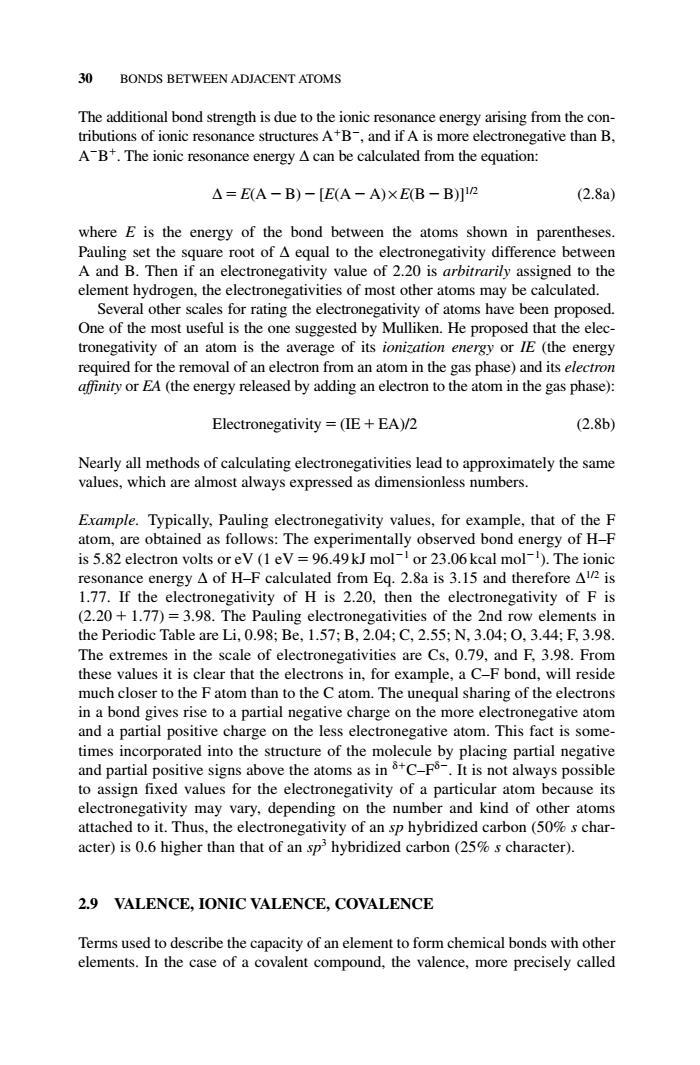正在加载图片...

30 BONDS BETWEEN ADJACENT ATOMS The additional bond strength is due to the ionic resonance energy arising from the con- tributions of ionic resonance structures A+B-,and if A is more electronegative than B. A-B+.The ionic resonance energy A can be calculated from the equation: A=E(A-B)-IE(A-A)XE(B-B)11 (2.8a where E is the energy of the bond between the atoms shown in parentheses Pauling set the square root of A equal to the electronegativity difference between A and B.Then if an electronegativity value of 2.20 is arbitrarily assigned to the element hydrogen,the electronegativities of most other atoms may be calculated. Several other scales for rating the electronegativity of atoms have been proposed. One of the most useful is the one suggested by Mulliken.He proposed that the elec- tronegativity of an atom is the average of its ionization energy or IE (the energy required for the removal of an electron from an atom in the gas phase)and its elec affiniry or EA(the energy released by adding an electron to th e atom in the gas phase) Electronegativity=(IE+EA)/2 (2.8b) Nearly all methods of calculating electronegativities lead to approximately the same values,which are almost always expressed as dimensionless numbers. Example.Typically.Pauling electronegativity values.for example.that of the f atom.are obtained as follows:The ex xperimentally observed bond ene reV(1eV=96. ce energy A of H-】 cal from Eq.2.8a a3.15 and there 1.77.If the electronegativity of H is 2.20,then the electronegativity of F is (2.20+1.77)=3.98.The Pauling electronegativities of the 2nd row elements in the Periodic Table are Li.0.98:Be.1.57:B.2.04:C.2.55:N.3.04:O.3.44:F.3.98. The extremes in the scale of electronegativities are Cs,0.79,and F,3.98.From these values it is clear that the electrons in,for example,a C-F bond,will reside much closer to the fatom than to the c ato m.The une qual sharing of the electrons in a bond gives rise to a partial arge on the elect ive aton charge on the le ectronegative atom.This paaen e m2p既we by placing partial negative to assign fixed values for the electronegativity of a particular atom because its electronegativity may vary,depending on the number and kind of other atoms attached to it.Thus,the electronegativity of an sp hybridized carbon(50%s char- acter)is 0.6 higher than that of an sp hybridized carbon (25%s character). 2.9 VALENCE,IONIC VALENCE,COVALENCE Terms used to describe the capacity of an element to form chemical bonds with other elements.In the case of a covalent compound,the valence,more precisely called The additional bond strength is due to the ionic resonance energy arising from the contributions of ionic resonance structures AB, and if A is more electronegative than B, AB. The ionic resonance energy ∆ can be calculated from the equation: ∆ E(A B) [E(A A) ×E(B B)]1/2 (2.8a) where E is the energy of the bond between the atoms shown in parentheses. Pauling set the square root of ∆ equal to the electronegativity difference between A and B. Then if an electronegativity value of 2.20 is arbitrarily assigned to the element hydrogen, the electronegativities of most other atoms may be calculated. Several other scales for rating the electronegativity of atoms have been proposed. One of the most useful is the one suggested by Mulliken. He proposed that the electronegativity of an atom is the average of its ionization energy or IE (the energy required for the removal of an electron from an atom in the gas phase) and its electron affinity or EA (the energy released by adding an electron to the atom in the gas phase): Electronegativity (IE EA)/2 (2.8b) Nearly all methods of calculating electronegativities lead to approximately the same values, which are almost always expressed as dimensionless numbers. Example. Typically, Pauling electronegativity values, for example, that of the F atom, are obtained as follows: The experimentally observed bond energy of H–F is 5.82 electron volts or eV (1 eV 96.49 kJ mol1 or 23.06 kcal mol1). The ionic resonance energy ∆ of H–F calculated from Eq. 2.8a is 3.15 and therefore ∆1/2 is 1.77. If the electronegativity of H is 2.20, then the electronegativity of F is (2.20 1.77) 3.98. The Pauling electronegativities of the 2nd row elements in the Periodic Table are Li, 0.98; Be, 1.57; B, 2.04; C, 2.55; N, 3.04; O, 3.44; F, 3.98. The extremes in the scale of electronegativities are Cs, 0.79, and F, 3.98. From these values it is clear that the electrons in, for example, a C–F bond, will reside much closer to the F atom than to the C atom. The unequal sharing of the electrons in a bond gives rise to a partial negative charge on the more electronegative atom and a partial positive charge on the less electronegative atom. This fact is sometimes incorporated into the structure of the molecule by placing partial negative and partial positive signs above the atoms as in δC–Fδ. It is not always possible to assign fixed values for the electronegativity of a particular atom because its electronegativity may vary, depending on the number and kind of other atoms attached to it. Thus, the electronegativity of an sp hybridized carbon (50% s character) is 0.6 higher than that of an sp3 hybridized carbon (25% s character). 2.9 VALENCE, IONIC VALENCE, COVALENCE Terms used to describe the capacity of an element to form chemical bonds with other elements. In the case of a covalent compound, the valence, more precisely called 30 BONDS BETWEEN ADJACENT ATOMS c02.qxd 5/17/2005 5:13 PM Page 30�������������